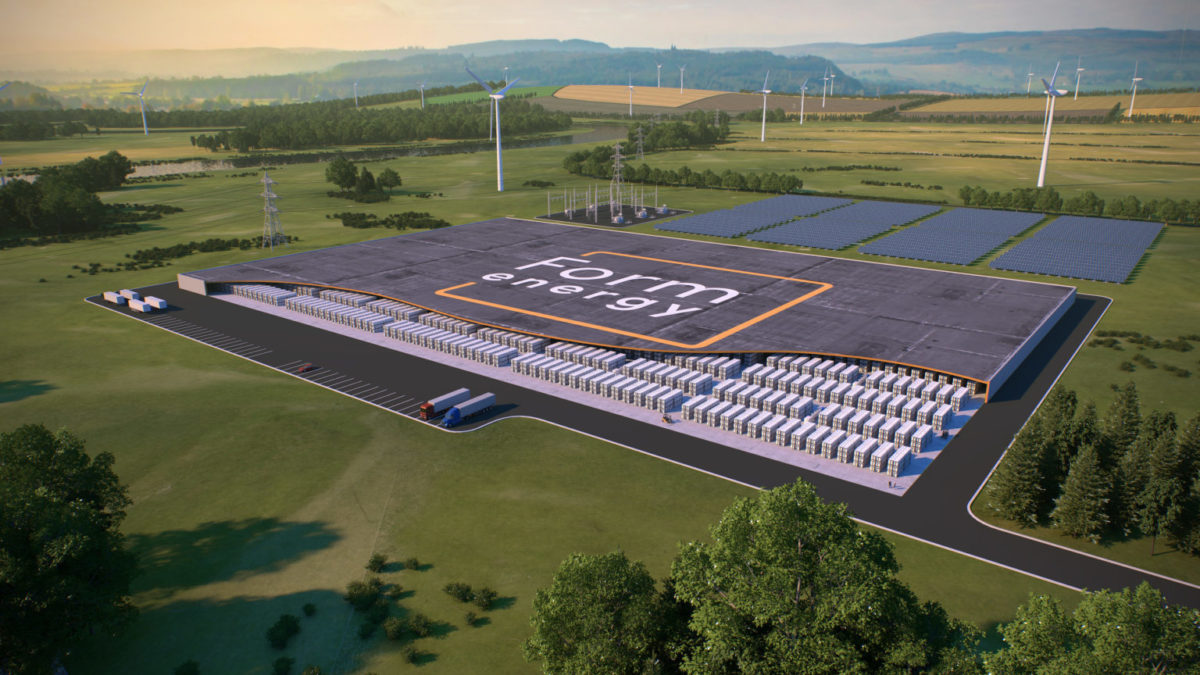From pv magazine USA
Solar and wind power have variability in their productive hours, as multi-day weather events can impact output. Therefore, multi-day storage that is cost effective is important in grid reliability.
This is the logic that supported the creation of Boston startup Form Energy’s iron-air batteries. The grid-scale batteries can store intermittent renewables-sourced electricity for 100 hours at costs competitive with conventional power plants.
Utility Xcel Energy said it will install two 10 MW/1,000 MWh iron-air batteries – one at a retired coal plant in Minnesota and another on a restored site in Colorado. The projects are expected to go online in 2025, following regulatory approval.
The iron-air battery is composed of cells filled with thousands of iron pellets that are exposed to air, creating rust. The oxygen is then removed, reverting the rust to iron. Controlling this process allows the battery to be charged and discharged.
The technology is less energy-dense than its lithium-ion counterparts, making it a better fit for large grid-scale applications. This may come as an advantage for the company, as EV batteries are in competition for lithium, a metal with geo-political mining concerns and battery fire risks.
“Form was founded with a unified mission to develop a multi-day energy storage battery that would unlock the power of extremely low-cost renewable energy to transform the electric grid,” said Mateo Jaramillo, co-founder and chief executive officer of Form Energy.
Form Energy said an individual battery module is about the size of a side-by-side washer/dryer set and contains a stack of approximately 50 one-meter-tall cells. The cells include iron and air electrodes, the parts of the battery that enable the electrochemical reactions to store and discharge electricity. Each of these cells are filled with water-based, non-flammable electrolyte, like the electrolyte used in AA batteries.
These battery modules are grouped together in environmentally protected enclosures. Hundreds of these enclosures are grouped together in modular megawatt-scale power blocks. Depending on the system size, tens to hundreds of these power blocks can be connected to the electricity grid. For scale, in its least dense configuration, a one-megawatt system comprises half an acre of land. Higher density configurations would achieve >3 mw/acre.
Popular content
“We’re on track to reduce our electric system carbon emissions 80% by 2030 and to deliver carbon-free electricity by 2050,” said Bob Frenzel, chief executive officer of Xcel Energy. “As we build more renewable energy into our systems, our partnership with Form Energy opens the door to significantly improve how we deliver carbon-free energy.”
Form Energy held a $200 million Series D funding round in 2021 led by ArcelorMittal and a $450 million Series E round led by TPG Rise Climate, and numerous Canada-based funds.
In December, it announced a West Virginia-based manufacturing facility. Emerging from startup mode, Form expects to begin construction of its Weirton factory in 2023 and start manufacturing iron-air batteries in 2024 for broad commercialization.
The governor of West Virginia, Jim Justice, said that the state was able to structure a unique financial incentive package worth up to $290 million in asset-based, performance financing to support their decision to locate in Weirton. The West Virginia Economic Development Authority allocated $75 million toward the purchase of land and the construction of buildings in Weirton. The governor said he plans on working with the West Virginia Legislature and federal partners to obtain an additional $215 million needed to finalize the agreement.
The Xcel collaboration was modeled using Form Energy’s investment and operational modeling tool for grids, called Formware. This modeling helped Xcel Energy validate how Form’s multi-day storage will support Xcel Energy’s ability to reliably and cost-effectively integrate large amounts of wind energy and other renewable resources on its system.
Additionally, this analysis demonstrated how the 100-hour iron-air battery technology will strengthen the grid against normal day-to-day, week-to-week, and season-to-season weather variability, in addition to extreme weather events including severe winter storms and polar vortex events.
“Xcel Energy operates across some of the richest wind-resource areas in North America,” said Jaramillo. “This partnership highlights Xcel Energy’s commitment to ensuring grid resiliency and reliability, energy security, and access to low-cost clean energy when and where it is needed – every day of the year.”
This content is protected by copyright and may not be reused. If you want to cooperate with us and would like to reuse some of our content, please contact: editors@pv-magazine.com.



By submitting this form you agree to pv magazine using your data for the purposes of publishing your comment.
Your personal data will only be disclosed or otherwise transmitted to third parties for the purposes of spam filtering or if this is necessary for technical maintenance of the website. Any other transfer to third parties will not take place unless this is justified on the basis of applicable data protection regulations or if pv magazine is legally obliged to do so.
You may revoke this consent at any time with effect for the future, in which case your personal data will be deleted immediately. Otherwise, your data will be deleted if pv magazine has processed your request or the purpose of data storage is fulfilled.
Further information on data privacy can be found in our Data Protection Policy.